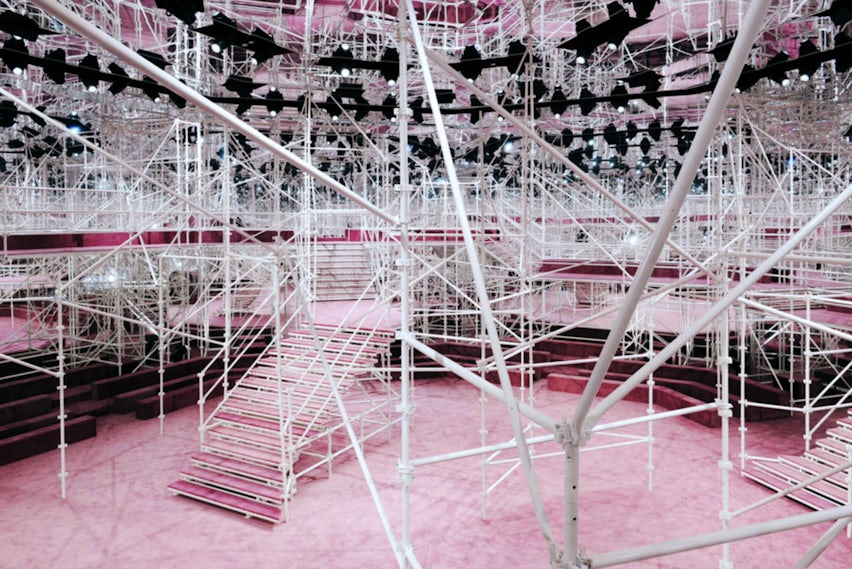On April 24th, 2013, the building known as Rana Plaza, located in the town of Savar, Bangaladesh, collapsed. The structure housed clothing factories and shops crammed into poorly planned space where around 5,000 people total were employed. The factories in the building supplied garments to companies including Benetton, Primark, and Walmart.

Cranes were brought in to assist in the cleanup effort.
The work day began as it would, but with a hint of anxiety owing to the fact that the building had been evacuated the previous day due to structural concerns and cracks in the wall. Workers nevertheless filed into the building that morning because factory managers had threatened to withhold their wages if they did not show up for work.
Shortly before 9 a.m., a tremor that witnesses said felt like an earthquake rocked the building as it collapsed around its occupants. Rescue personnel arrived on the scene and attempted to find survivors and remove them from the rubble. The collapsed building remained unstable, a pile of concrete rubble, clothes, and machinery. Authorities needed to move as quickly as possible to find survivors, meaning that rescue efforts were dangerous and involved long, grueling hours of work. When the final tally was taken mid-May, over 1,100 people were dead, twice as many had been injured, and many were left jobless. These casualties gave the event the unfortunate distinction as the deadliest garment-factory disaster and highest loss of life in a building collapse since 9/11.

A view of the collapsed Rana Plaza Building.
What followed was outrage over working conditions in one of the poorest nations in the world, the ever-rising human cost of the garment industry, and a critique of the Western world’s demand for cheap clothing and the corporations who provide it.

A fire destroyed Tazreen Fashions in Bangladesh in 2012
As the story broke, the building’s owner and namesake, Mohammed Sohel Rana, was arrested along with his father and four other owners. Police also arrested the engineer who’d called for the previous day’s evacuation. He had been responsible for illegally adding four floors to the top of the building without any supporting walls, a factor that contributed to the collapse. This practice of illegal building is prevalent in the Indian subcontinent in alarming numbers.

Diagram showcasing the cause of the collapse.
The building’s original architect, Massood Reza, told reporters after the collapse that the building was not made to hold factory equipment. “We did not design it for industrial use,” Reza said. “At that time, the garment [area] was not there. There was no demand for industrial buildings. If I had known that it was to be an industrial building, as per the rules I would have taken other measures for the building.”

Rescue workers and volunteers utilize long sheets of textile to slide the dead and the injured to safety.
Strict building standards and higher accountability for poor construction are needed to avoid such tragedies, as New Yorkers learned in the aftermath of the Triangle Shirtwaist Factory Fire of 1911. On March 25 of that year, a blaze that started in a rag bin engulfed the entire building in Lower Manhattan. Workers who sought to escape were prevented from doing so by locked doors (meant to keep them at work), a fire escape that opened inward, and one narrow hallway leading to the only working elevator. A total of 145 people, women who were mostly recent immigrants, died in the fire. When the public found out about the factory’s cramped conditions, poor design, and harsh treatment of its workers (all employees worked 12-hour days and made $15 a week), the outcry was sharp and severe. As a result, legislators passed the Sullivan-Hoey Fire Prevention Law in 1911. In Bangladesh, the legislative response has been mild, and conditions remain largely the same.

Inside of the Triangle Shirtwaist Factory after the fire (1911)
The question remains: What is architecture’s role in a situation like this? Though the situation in Bangladesh has unique dynamic because of the government’s ties to the garment industry, the authorities’ failure to regulate building codes, and the way that economies are shaped as a result of negative externalities, designers and planners can still extract a lesson from the tragedy.
Architects, Designers, and Planners for Social Responsibility (ADPSR) is an organization that “works for peace, environmental protection, ecological building, social justice, and the development of healthy communities.” This 501(c)3 public-benefit organization was started in 1981 as a platform pushing for nuclear disarmament and fighting military excesses. Honored by the AIA, this group campaigns for causes including green building and human rights in prisons. They have set up a petition to amend the AIA ethics code to include a prohibition of the design of spaces where “killing, torture, and cruel, inhuman or degrading treatment” take place. (You can listen to Roman Mars discussADPSR and the Pelican Bay State Prison on his podcast, “99% Invisible.”)
This lesson can be applied to any structure that degrades quality of life and puts its occupants in danger. A strong voice here can grow into a loud demand that the international community impose harsher oversight of building codes, ethics, and safety in countries where corruption is abundant and economic externalities distance us from the source of our goods. In the meantime, the aftermath of Rana Plaza and other garment factory disasters will serve as a painful reminder that life safety in buildings must never be taken for granted.
Images via Press TV, Rijans, Reuters, Getty Images, and PBS.









